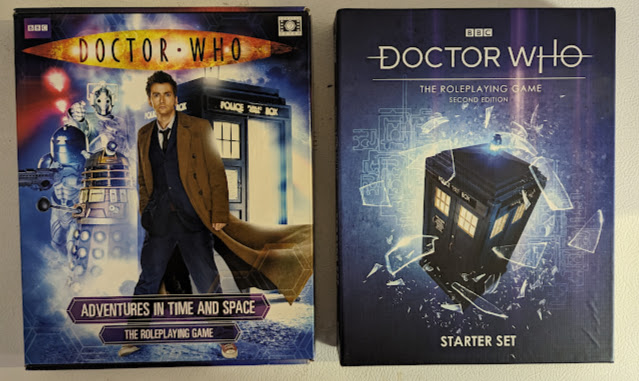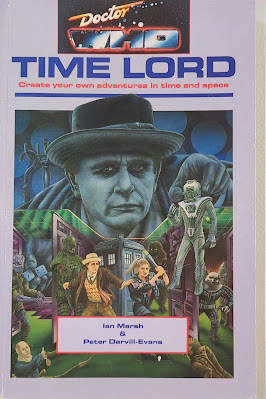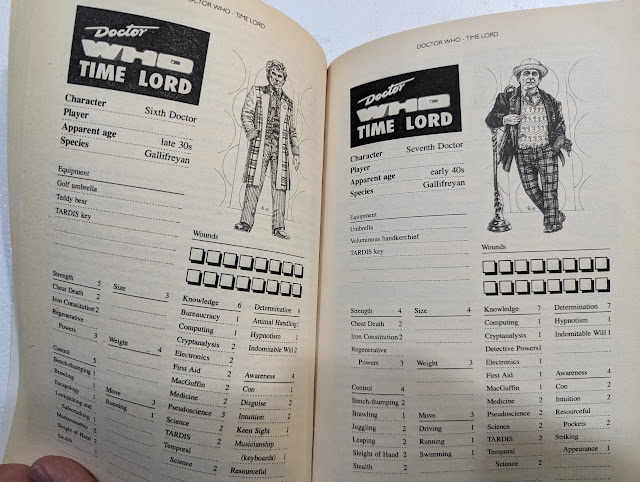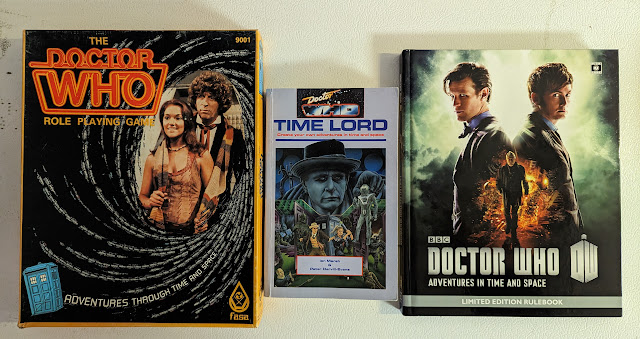Expanding Star Trek Adventures
 In all of the eleven roleplaying games based on Star Trek,
it is surprising to note that there have exactly three setting supplements
between all of them. Of course, it could be argued that the future depicted in
Star Trek is a setting in itself, but as to specific supplements which focus on
a setting or location for play, well, still three. For FASA’s Star Trek: TheRole Playing Game,
the Trader Captains and Merchant Princes supplement introduced the lawless
region of The Triangle, caught between the United Federation of Planets, the
Klingon Empire, and the Romulan Star Empire, and then developed properly, in
The Triangle supplement. For Last Unicorn Games, there was the Starfleet
Academy boxed set, which enabled players to roleplay a campaign at the academy
and beyond. That then is two of them, but Star Trek Adventures,
the Star Trek roleplaying game from Modiphius Entertainment has a setting supplement of its own and it is literally bigger and more
expansive than the other two. This is the Shackleton Expanse Campaign Guide.
In all of the eleven roleplaying games based on Star Trek,
it is surprising to note that there have exactly three setting supplements
between all of them. Of course, it could be argued that the future depicted in
Star Trek is a setting in itself, but as to specific supplements which focus on
a setting or location for play, well, still three. For FASA’s Star Trek: TheRole Playing Game,
the Trader Captains and Merchant Princes supplement introduced the lawless
region of The Triangle, caught between the United Federation of Planets, the
Klingon Empire, and the Romulan Star Empire, and then developed properly, in
The Triangle supplement. For Last Unicorn Games, there was the Starfleet
Academy boxed set, which enabled players to roleplay a campaign at the academy
and beyond. That then is two of them, but Star Trek Adventures,
the Star Trek roleplaying game from Modiphius Entertainment has a setting supplement of its own and it is literally bigger and more
expansive than the other two. This is the Shackleton Expanse Campaign Guide.The Shackleton Expanse Campaign Guide is set far beyond Federation and Klingon space, in the Beta Quadrant. This presents a barely explored region of space, known for its strange spatial phenomena and rumours of an ancient, lost civilisation, which is being opened up to exploration, colonisation, and trade. Here on the edge of the Expanse, the Federation and the Klingons have built and established Starbase 364, also known as Narendra Station in tribute to the Klingon colonists massacred by a Romulan sneak attack at the Narendra III outpost in 2344 and the heroic sacrifice of the USS Enterprise-C in defending them. The Federation and the Klingons jointly run the station. In game terms, this set-up leads to some fantastic campaign possibilities. At its heart, the Shackleton Expanse Campaign Guide is a station-based campaign, much in the mode of Deep Space 9, although the Player Characters are going to have their own starship too. The setting can be run with an all-Federation crew or an all-Klingon crew, or even a mixed crew, further supporting the joint nature of Narendra Station. With some development upon the part of the Game Master, a campaign could be run which does not focus upon a Federation or Klingon crew, but instead around themes such as trade—the Ferengi and the Orions are active in the area, espionage—the Romulans have interest in activities on their border and the technological secrets to be found in the Shackleton Expanse, or even crime—the Orion Syndicate known to be operating in the region. Whichever way a Game Master decides to use the Shackleton Expanse Campaign Guide, the Star Trek Adventures: The Klingon Empire roleplaying game will be useful. Also useful will be the Beta Quadrant Sourcebook which covers the background and broad history of the whole of the quadrant as well as first mentioning the Shackleton Expanse.
The Shackleton Expanse Campaign Guide presents a whole new setting for the Star Trek: The Original Series and Star Trek: The Next Generation periods of Star Trek Adventures. This includes, a region guide and an explanation of the strange spatial, spectral, and gravimetric phenomena which can disrupt ship’s systems or even destroy a ship completely; five new playable species, including four indigenous to the setting and one found everywhere; details of both NPCs and starships to be found in the region; and advice on running a campaign in the setting. The highlight of the supplement is ‘The Tilikaal Saga’, a complete ten-part campaign that spans the Star Trek: The Original Series and Star Trek: The Next Generation eras and through the actions of the Player Characters, will profoundly affect the future of the Shackleton Expanse. All of this is supported with historical excerpts, personal logs, and intercepted communications that add flavour and detail as well as differing points of view—the Klingon security report on the Orions and the Orion Syndicate is most amusing.
The Shackleton Expanse Campaign Guide opens with an overview of the region and its known history, highlighting the lack of knowledge that the Federation has about the Shackleton Expanse, an explanation of the push to explore and open up the region, a description of Starbase 364 or Narendra Station, the spatial phenomena which makes travel so dangerous and exploration so intriguing, and the various factions known to be active in the region. The history begins with the initial exploration by the U.S.S. Lexington in 2269, which would see one world quarantined and limit Federation activity in the region for almost a century. A combination of closer Klingon co-operation and increased scientific interest has spurred the construction of a permanent base and support for further exploration (which is where the Player Characters and their starship come in). The description of Narendra Station is detailed enough to bring it alive, but still leave plenty of room for the Game Master to add extra details, especially if she wants to run adventures Deep Space 9 style on the station. The factions covered include the United Federation of Planets, the Klingon Empire, the Romulan Star Empire, and the Orion Syndicate, as well as four species native to the Shackleton Expanse, which the Federation has either limited contact with or is monitoring under the terms of the Prime Directive. These include the Akaru, a humanoid species which combine the best of Vulcan and Romulan traits and are highly efficient; the Cal-Mirran, a crystalline species which communicates via light and has the capacity to distort time and look into the past or the future; the Qofuari, Otter-like centauroids who can mentally image, model, and test technologies and theories; and the VinShari, a dominate humanoid species with powerful vocal abilities which can be deadly. Full stats are provided for all four species, as well as the Orions later in the supplement, enabling their creation as both Player Characters and NPCs. However, since contact is initially limited with the four native species, they are best used as NPCs at first, and then as possible Player Characters once they have been encountered and reasons developed as why they can become Player Characters. The VinShari are likely to be the aggressive species for any campaign, but all four species are nicely detailed and feel alien to one degree or another.
All this leads up to the Tilikaal and ‘The Tilikaal Saga’. The Tilikaal are an ancient race, akin to the Preservers, Iconians, and Organians, who disappeared long ago leaving behind worlds with strange machinery built deep into their bowels or massive structures that cover the whole of the planetary surface, as well as spectral phenomena which defy known science in 2269, let alone 2371. The Tilikaal themselves and then their known worlds and their technology are described in detail before delving into the campaign. This begins in the Star Trek: The Original Series era with the first two parts, before moving onto the Star Trek: The Next Generation era for the remaining eight. Thus, from the start there is an imbalance to the campaign, particularly for a group playing in the Star Trek: The Original Series era, who get less time in the campaign. There are suggestions for involving the Star Trek: The Original Series era, who are intended to be crewmembers aboard the U.S.S. Lexington, in the rest of the campaign in the Star Trek: The Next Generation era, such as time travel or particularly long-lived characters, such as Vulcans. The methods suggested do feel forced though and whilst the first two parts of the campaign are integral to the whole, they feel like an introduction to the main campaign in the Star Trek: The Next Generation era.
‘The Tilikaal Saga’ will see the Player Characters ranging back and forth across the Shackleton Expanse. They will not only be examining the effects of the spatial phenomena and their causes and following on further clues as to the nature of the Tilikaal and their technology, but they will also be encountering the new species across the Shackleton Expanse and interreacting with both them and members of the other factions with an interest in the region. There are some great scenes throughout the campaign as the Player Characters and their starship travel to pocket dimensions; lead a flotilla simultaneously holding off a Romulan squadron, land a starship on a planet to conduct an evacuation, and delaying one planet from crashing into another—which is all incredibly epic; and more.
Having originated as a Living Campaign released as a series of PDFs, ‘The Tilikaal Saga’ has an episodic structure, enabling the Game Master to slot other scenarios in between the main episodes. To that end, the supplement includes ten one-page scenario outlines or Mission Briefs for the Star Trek: The Original Series era and twenty-seven for the Star Trek: The Next Generation era. Again, there is an imbalance between the two eras, but the inclusion of the Mission Briefs for the Star Trek: The Original Series era does at least offset the short length of the era’s involvement in the campaign. Each of the Mission Briefs is nicely done with suggested spotlight role for each one, plus the story beats—major and minor, NPCs involved, and suggestions as to when to run into between the episodes of the campaign. All of which is supported by general advice on running the campaign and story arcs in the Shackleton Expanse.
To support the Game Master, the Shackleton Expanse Campaign Guide includes details for the various NPCs, adversaries and allies, involved in both campaign and setting. These include the staff aboard Narendra Station, as well as NPCs for the Star Trek: The Original Series era, and then Klingons, Orions, and NPCs from across the Shackleton Expanse. Details are also provided for the various vessels involved. This includes the U.S.S. Lexington for the Star Trek: The Original Series era, and then an Akira-Class, Galaxy-Class, and Intrepid-Class vessel for the Star Trek: The Next Generation era. These are the U.S.S. Thunderchild, the U.S.S. Venture, and the U.S.S. Bellerophon respectively, and each comes its own history and background. There are plenty of other vessels from across the region too. Lastly, there are notes for Game Master if she wants to create her version of the Shackleton Expanse.
Physically, behind the lovely cover, the Shackleton Expanse Campaign Guide has some of the same problems as Star Trek Adventures: The Roleplaying Game core rulebook—the use of the LCARS—Library Computer Access/Retrieval System—operating system as a style template. Again, the mix of white text and pastel colours on black is not easy to read. (This does not apply to the Mission Briefs for the Star Trek: The Original Series era, so they are easy to read.) Nor do the maps look particularly good on the black background and they not particularly interesting maps at that. However, the Shackleton Expanse Campaign Guide does not feel as compact a book in places and so is easier to read.
Noticeable also, is the range of artwork on show. This is a completely new supplement with completely new species and setting and so the supplement gives new artwork to depict both them and the setting. Unfortunately, though, not all of the NPCs are illustrated, which will be a problem for the Game Master to present in play.
The Shackleton Expanse Campaign Guide is Federation-focused and thus Starfleet-focused. Which means that although there is advice for running the campaign and individual scenarios with an all-Klingon crew and starship, this comes off as second best by comparison. It always feels as if Klingon interests are aligned with the Federation interests and that is not always true. Perhaps a scenario or two, or a Mission Brief could have been included designed to be played by Klingons, but with notes for running its using Starfleet Player Characters rather than the other way around. Another area where the Shackleton Expanse Campaign Guide is at its weakest is in advice for the Game Master. The advice on running the campaign and individual scenarios is fine, but there is no advice on running campaigns with a fixed point of reference, in this case, a starbase like that of Deep Space 9. Essentially, the Game Master will need to await a supplement dedicated to Deep Space 9 or starbase-style campaigns for that advice.
The Shackleton Expanse Campaign Guide covers a lot of setting and a lot of adventure. In fact, ‘The Tilikaal Saga’ will provide months’ worth of play, especially if the Game Master includes the numerous Mission Briefs to round out the campaign and structure it more like a season or two of a Star Trek series. After all, with the ten parts of the campaign and the almost forty Mission Briefs there is enough here for that, plus whatever the Game Master adds. In addition, the Shackleton Expanse Campaign Guide and ‘The Tilikaal Saga’ together open up Star Trek Adventures to more than just what is portrayed on screen, not only expanding the setting of Star Trek, but also providing content that is unique to the Modiphius Entertainment roleplaying game.
The Shackleton Expanse Campaign Guide provides Star Trek Adventures with an all-new setting and the epic campaign it has been waiting for. In fact, first campaign for any Star Trek roleplaying game! The Game Master will find everything she needs to run this campaign and her own in its pages for a whole season of Star Trek roleplaying—if not more.
—oOo—

Modiphius Entertainment will be at UK Games Expofrom Friday 2nd to Sunday 4th, 2023.



























